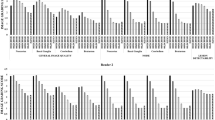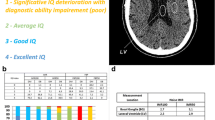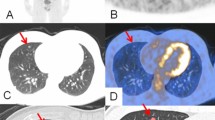Abstract
Purpose
We aimed to evaluate the effectiveness of the brain region imaging in FDG-PET/CT scanning of patients with suspected or diagnosed lung cancer.
Materials and methods
We performed the study retrospectively on the medical charts of 427 patients. We divided the FDG-PET/CT field of view (FOV) into four major imaging regions: brain, head–neck, abdomen and pelvis. Metastatic findings on these regions were checked and determined the potential of these findings to affect the chemotherapy or radiotherapy protocol or surgical management. If metastatic findings had a potential to modify these parameters, we named this situation as “clinical contribution”. Considering the number of bed positions of these regions, we calculated the clinical contribution of each region and named as “effective clinical contribution”. Then, we calculated the metastatic findings, clinical contribution, and effective clinical contribution ratios.
Results
We found different brain metastasis ratios for lung cancer, solitary pulmonary mass (SPM), and solitary pulmonary nodule (SPN) groups (8.7, 2.8 and 0.9 %, respectively). In addition, the clinical contribution and effective clinical contribution ratios in the brain region for these three groups were 6.4, 2.8, 0.0 and 6.4, 2.8, 0.0 %, respectively. The highest metastatic findings (30.6 %) and clinical contribution (9.8 %) ratios were found in the abdomen region of the lung cancer group. However, the highest effective clinical contribution ratio (6.8 %) was found in the brain region within the same group.
Conclusions
The addition of the brain region to the limited whole-body FOV in FDG-PET/CT scanning seems to be effective in the lung cancer and SPM groups, but not in the SPN group.




Similar content being viewed by others
References
Delbeke D, Coleman RE, Guiberteau MJ et al (2006) Procedure guideline for tumor imaging with 18F-FDG PET/CT 1.0. J Nucl Med 47:885–895
Avril N (2004) GLUT1 expression in tissue and (18) F-FDG uptake. J Nucl Med 45:930–932
Abikhzer G, Alabed YZ, Azoulay L et al (2011) Altered hepatic metabolic activity in patients with hepatic steatosis on FDG PET/CT. Am J Roentgenol 196:176–180
Boellaard R, O’Doherty MJ, Weber WA et al (2010) FDG PET and PET/CT: EANM procedure guidelines for tumor PET imaging: version 1.0. Eur J Nucl Med Mol Imaging 37:181–200
ACR-SPR practice guideline for performing FDG-PET/CT in oncology. American College of Radiology Web site. http://www.acr.org/~/media/71B746780F934F6D8A1BA5CCA5167EDB.pdf Accessed 07 Jan 2014
Lee HY, Lee KS, Kim BT et al (2009) Diagnostic efficacy of PET/CT plus brain MR imaging for detection of extrathoracic metastases in patients with lung adenocarcinoma. J Korean Med Sci 24:1132–1138
Sebro R, Mari-Aparici C, Hernandez-Pampaloni M (2013) Value of true whole-body FDG-PET/CT scanning protocol in oncology: optimization of its use based on primary diagnosis. Acta Radiol 54:534–539
Bochev P, Klisarova A, Kaprelyan A et al (2012) Brain metastases detectability of routine whole-body (18)F-FDG PET and low dose CT scanning in 2502 asymptomatic patients with solid extracranial tumors. Hell J Nucl Med 15:125–129
Kitajima K, Nakamoto Y, Okizuka H et al (2008) Accuracy of whole-body FDG-PET/CT for detecting brain metastases from non-central nervous system tumors. Ann Nucl Med 22:595–602
Osman MM, Chaar BT, Muzaffar R et al (2010) 18F-FDG PET/CT of patients with cancer: comparison of whole-body and limited whole-body technique. AJR Am J Roentgenol 195:1397–1403
Tasdemir B, Dostbil Z, Inal A et al (2014) Evaluation of clinical contributions provided by addition of the brain, calvarium, and scalp to the limited whole-body imaging area in FDG-PET/CT tumor imaging. Biomed Res Int 2014:129683. doi:10.1155/2014/129683 Epub 2014 Jun 16
Abdelmalik AG, Alenezi S, Muzaffar R et al (2013) The incremental added value of including the head in (18)F-FDG PET/CT imaging for cancer patients. Front Oncol 3:71
Salvatore B, Caprio MG, Fonti R et al (2014) Is 2-deoxy-2-[(18)F]fluoro-d-glucose PET/CT acquisition from the upper thigh to the vertex of skull useful in oncological patients? Transl Med UniSa 19(11):34–38
Huston SF, Abdelmalik AG, Nguyen NC et al (2010) Whole-body 18F-FDG PET/CT: the need for a standardized field of view–a referring-physician aid. J Nucl Med Technol 38:123–127
Author information
Authors and Affiliations
Corresponding author
Ethics declarations
Conflict of interest
“The authors declare that they have no financial relationship with any organization related to the research.” The authors declare no conflict of interest.
Ethical approval
“Prior to the study, we obtained ethical approval from the institutional ethics committee and all study protocols were approved by the committee.”
Informed consent
“As the study is retrospective, we did not use any informed consent form.”
Rights and permissions
About this article
Cite this article
Tasdemir, B., Urakci, Z., Dostbil, Z. et al. Effectiveness of the addition of the brain region to the FDG-PET/CT imaging area in patients with suspected or diagnosed lung cancer. Radiol med 121, 218–224 (2016). https://doi.org/10.1007/s11547-015-0597-y
Received:
Accepted:
Published:
Issue Date:
DOI: https://doi.org/10.1007/s11547-015-0597-y




